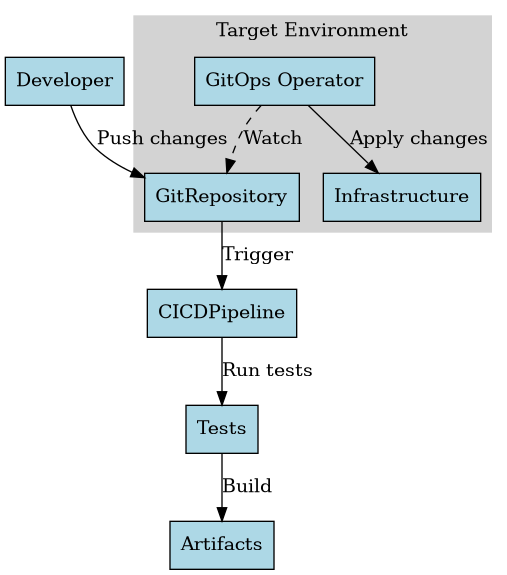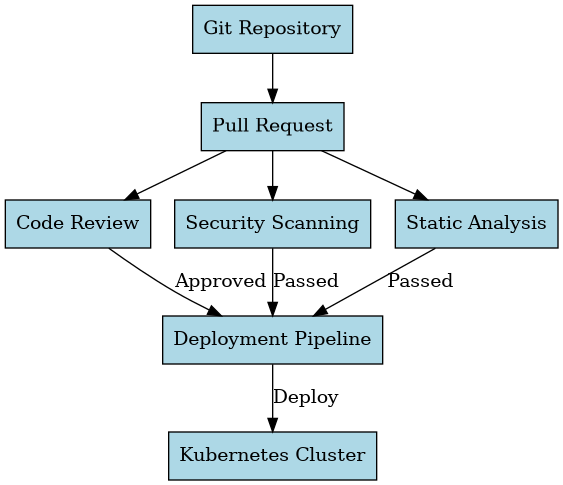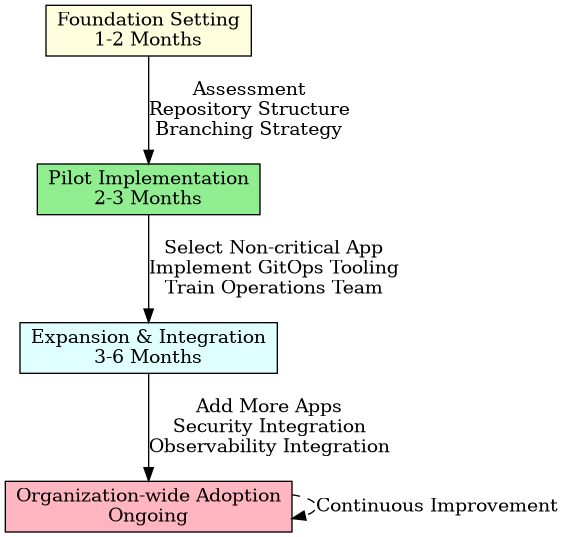GitOps: The Key to Infrastructure Sustainability
In the ever-evolving landscape of infrastructure management, GitOps has emerged as a beacon of hope for organizations striving for sustainability, reliability, and efficiency. This methodology, built on the principles of declarative infrastructure and version control, represents a fundamental shift in how we approach the management of complex systems.
The GitOps Revolution: From Push to Pull

Traditional infrastructure management often relied on push-based methodologies—engineers manually executing commands or pushing changes directly to production environments. This approach, while straightforward, created numerous challenges:
- Inconsistent Environments: Manually applied changes often led to configuration drift
- Limited Auditability: Tracking who made what change and when was difficult
- Fragile Rollback Mechanisms: Reverting problematic changes required complex procedures
- Tribal Knowledge: Critical infrastructure knowledge remained siloed within specific teams
GitOps flips this model on its head, establishing a pull-based approach where automated agents continuously monitor a Git repository and automatically apply changes to align the infrastructure with the declared state. This simple yet profound shift has transformative implications.
The Four Pillars of GitOps Implementation
Our experience implementing GitOps across dozens of organizations has revealed four critical pillars for success:
1. Declarative Infrastructure as Code

At the foundation of GitOps lies the principle of declaring your desired infrastructure state in code. This means:
- Infrastructure defined in YAML, JSON, or similar declarative formats
- Configuration explicitly stated rather than implicitly derived
- Desired state fully documented in version-controlled repositories
Real-world Impact: When a major financial institution adopted declarative IaC, they reduced environment provisioning time from 5 days to 45 minutes while virtually eliminating configuration discrepancies between environments.
2. Git as the Single Source of Truth

In a GitOps workflow, Git becomes more than just a code repository—it becomes the authoritative record of your infrastructure's intended state. This means:
- All infrastructure changes flow through Git
- Pull requests and code reviews become infrastructure reviews
- Git history provides a comprehensive audit trail
- Branching strategies map to deployment environments
Real-world Impact: After implementing Git as their single source of truth, a healthcare provider was able to demonstrate complete compliance with regulatory requirements during an audit by showing the exact history of all infrastructure changes—who made them, when, and why.
3. Continuous Reconciliation and Verification

The magic of GitOps happens in the continuous reconciliation loop—a process where software agents constantly compare the actual state of your infrastructure against the desired state defined in Git and automatically resolve discrepancies. This provides:
- Automatic drift detection and remediation
- Self-healing infrastructure capabilities
- Continuous verification of environment state
- Reduced manual intervention requirements
Real-world Impact: During a cloud region outage, a retail organization's GitOps-managed infrastructure automatically recovered in 11 minutes once the region was available again, compared to their legacy systems which required 6 hours of manual intervention.
4. Security and Compliance by Design

GitOps naturally enhances security posture through:
- Reduced access requirements to production environments
- Comprehensive audit trails for all changes
- Enforced review processes before changes are applied
- Integration with security scanning tools in the CI/CD pipeline
Real-world Impact: An enterprise software company integrated security scanning into their GitOps pipeline, resulting in a 73% reduction in security vulnerabilities reaching production and significantly faster remediation when issues were identified.
Tools of the Trade: The GitOps Ecosystem
The GitOps ecosystem has matured rapidly, with several powerful tools now available:
- Flux CD: A CNCF-graduated project offering Kubernetes-native GitOps capabilities with strong integration with Helm and Kustomize
- ArgoCD: A declarative, GitOps continuous delivery tool for Kubernetes with a rich UI and advanced synchronization options
- Jenkins X: An integrated CI/CD solution built around GitOps principles
- Crossplane: Extends GitOps principles to cloud resources beyond Kubernetes
Each tool has unique strengths, and choosing the right one depends on your specific requirements and existing technology stack.
Implementation Journey: From Concept to Reality

Implementing GitOps is a journey that requires careful planning and execution. Based on our experience guiding organizations through this transformation, we recommend:
Phase 1: Foundation Setting (1-2 Months)
- Assess current infrastructure management practices
- Define repository structure and access controls
- Establish branching strategies aligned with environments
- Create initial declarative templates for core infrastructure
Phase 2: Pilot Implementation (2-3 Months)
- Select a non-critical application or environment
- Implement GitOps tooling (e.g., Flux CD or ArgoCD)
- Configure reconciliation agents and initial policies
- Train operations teams on new workflows
Phase 3: Expansion and Integration (3-6 Months)
- Expand to additional applications and environments
- Integrate security scanning and policy enforcement
- Connect observability systems to monitor GitOps processes
- Refine workflows based on initial learnings
Phase 4: Organization-wide Adoption (Ongoing)
- Standardize GitOps practices across teams
- Implement advanced features (progressive delivery, etc.)
- Continuously improve automation and templating
- Measure and showcase business impact
Throughout this journey, focus on building capabilities iteratively rather than attempting a "big bang" migration.
Measuring Success: Beyond the Technical Metrics

How do you know if your GitOps implementation is delivering value? We recommend focusing on these key metrics:
- Deployment Frequency: How often can you safely deploy changes?
- Lead Time for Changes: How long does it take from commit to production?
- Mean Time to Recovery (MTTR): How quickly can you recover from failures?
- Change Failure Rate: What percentage of changes result in incidents?
- Infrastructure Cost Efficiency: Are you optimizing resource utilization?
One manufacturing client saw their deployment frequency increase 8x while simultaneously reducing their change failure rate by 62% after fully adopting GitOps principles.
Common Pitfalls and How to Avoid Them
Even well-planned GitOps implementations face challenges. Here are common pitfalls we've observed and strategies to avoid them:
Pitfall 1: Repository Structure Complexity
As organizations scale, repository structure can become unwieldy. Implement a clear separation of concerns between application and infrastructure repositories, and establish consistent patterns across teams.
Pitfall 2: Secret Management
Secrets don't belong in Git repositories. Implement secure secret management solutions like Sealed Secrets, Vault, or cloud-native secret stores that integrate with your GitOps workflow.
Pitfall 3: Managing Stateful Resources
Stateful resources require special consideration in GitOps workflows. Establish clear patterns for handling databases, persistent volumes, and other stateful components.
Pitfall 4: Team Adoption Resistance
Cultural transformation is often harder than technical implementation. Invest in training, create clear documentation, and showcase early wins to build momentum.
Conclusion: The Future is Declarative
The journey to GitOps is ultimately a journey toward operational maturity and infrastructure sustainability. By embracing declarative principles, version control as the single source of truth, and automated reconciliation, organizations can achieve unprecedented levels of reliability, security, and efficiency.
As we look to the future, we see GitOps principles extending beyond infrastructure into application configuration, security policies, and even business processes. The organizations that embrace this paradigm today will be well-positioned to navigate the increasingly complex technology landscape of tomorrow.
Are you ready to embark on your GitOps journey? The path may have challenges, but the destination—a more sustainable, reliable, and efficient infrastructure—is well worth the effort.